US History Since WWI: Depression, New Deal, Cold War, Gay Rights
VerifiedAdded on 2023/04/21
|9
|1952
|252
Essay
AI Summary
This essay examines significant challenges in 20th-century US history, including the causes of the Great Depression, Franklin D. Roosevelt's New Deal policies, the rise of Cold War tensions following World War II, and the impact of the Gay Rights Movement. It discusses the economic policies, trade concerns, and banking practices that contributed to the Great Depression, as well as the major legislation and organizations established under the New Deal to combat the economic crisis. The essay further explores how the arms race and differing ideologies between the USA and USSR led to Cold War tensions, affecting American culture and security. Finally, it highlights the legislative and cultural changes brought about by the Gay Rights Movement, including the decriminalization of homosexuality and increased societal acceptance.
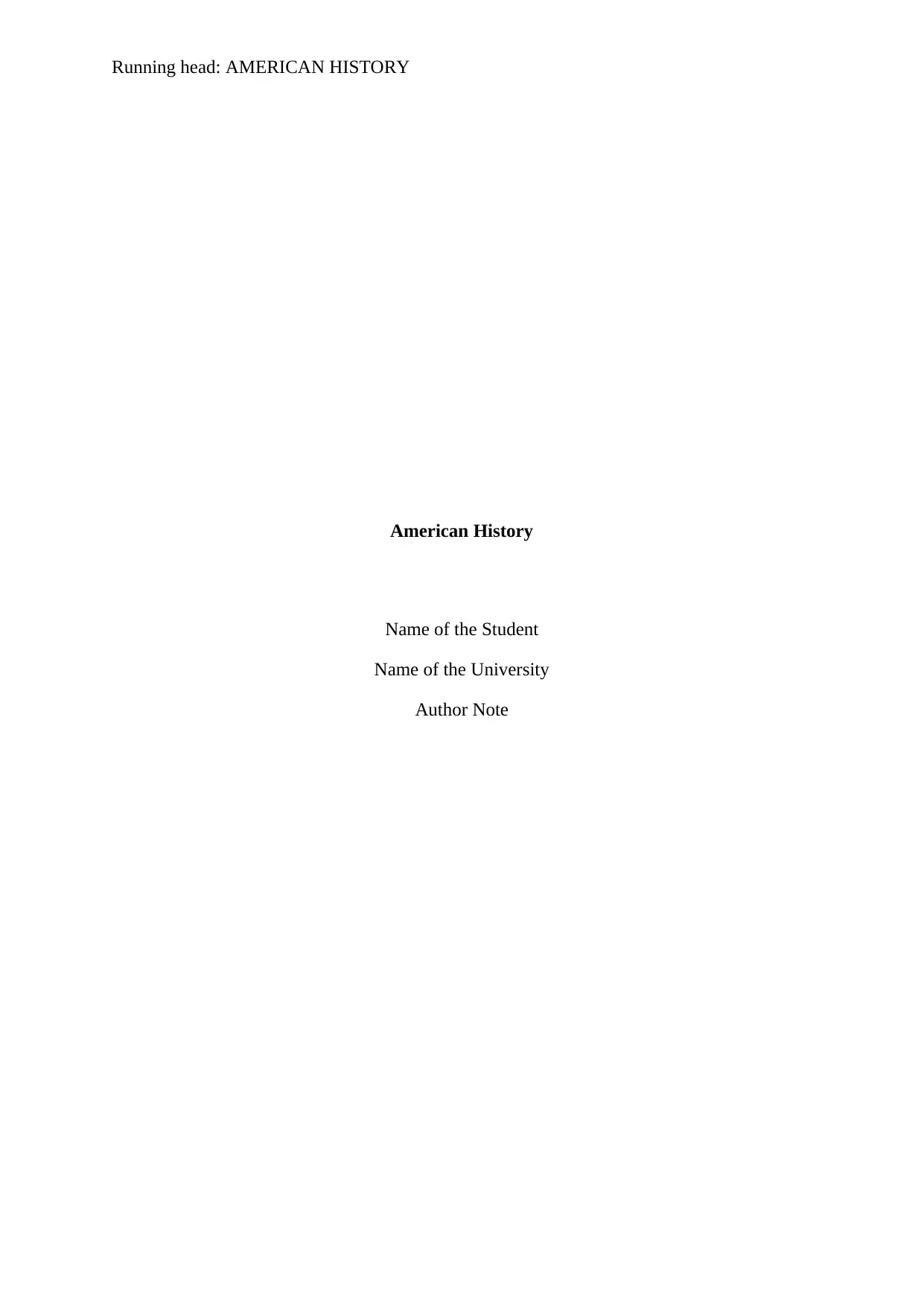
Running head: AMERICAN HISTORY
American History
Name of the Student
Name of the University
Author Note
American History
Name of the Student
Name of the University
Author Note
Paraphrase This Document
Need a fresh take? Get an instant paraphrase of this document with our AI Paraphraser
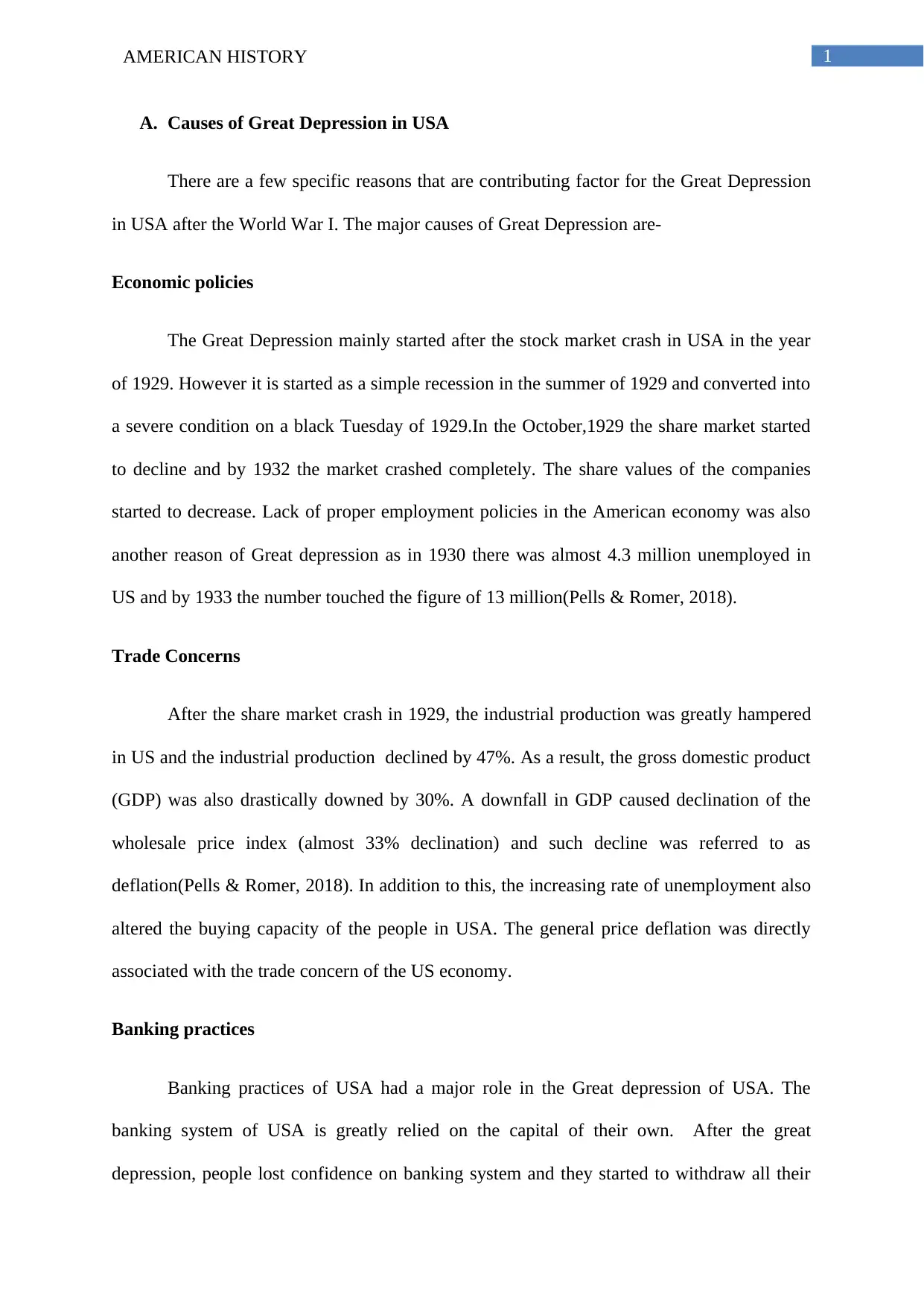
AMERICAN HISTORY 1
A. Causes of Great Depression in USA
There are a few specific reasons that are contributing factor for the Great Depression
in USA after the World War I. The major causes of Great Depression are-
Economic policies
The Great Depression mainly started after the stock market crash in USA in the year
of 1929. However it is started as a simple recession in the summer of 1929 and converted into
a severe condition on a black Tuesday of 1929.In the October,1929 the share market started
to decline and by 1932 the market crashed completely. The share values of the companies
started to decrease. Lack of proper employment policies in the American economy was also
another reason of Great depression as in 1930 there was almost 4.3 million unemployed in
US and by 1933 the number touched the figure of 13 million(Pells & Romer, 2018).
Trade Concerns
After the share market crash in 1929, the industrial production was greatly hampered
in US and the industrial production declined by 47%. As a result, the gross domestic product
(GDP) was also drastically downed by 30%. A downfall in GDP caused declination of the
wholesale price index (almost 33% declination) and such decline was referred to as
deflation(Pells & Romer, 2018). In addition to this, the increasing rate of unemployment also
altered the buying capacity of the people in USA. The general price deflation was directly
associated with the trade concern of the US economy.
Banking practices
Banking practices of USA had a major role in the Great depression of USA. The
banking system of USA is greatly relied on the capital of their own. After the great
depression, people lost confidence on banking system and they started to withdraw all their
A. Causes of Great Depression in USA
There are a few specific reasons that are contributing factor for the Great Depression
in USA after the World War I. The major causes of Great Depression are-
Economic policies
The Great Depression mainly started after the stock market crash in USA in the year
of 1929. However it is started as a simple recession in the summer of 1929 and converted into
a severe condition on a black Tuesday of 1929.In the October,1929 the share market started
to decline and by 1932 the market crashed completely. The share values of the companies
started to decrease. Lack of proper employment policies in the American economy was also
another reason of Great depression as in 1930 there was almost 4.3 million unemployed in
US and by 1933 the number touched the figure of 13 million(Pells & Romer, 2018).
Trade Concerns
After the share market crash in 1929, the industrial production was greatly hampered
in US and the industrial production declined by 47%. As a result, the gross domestic product
(GDP) was also drastically downed by 30%. A downfall in GDP caused declination of the
wholesale price index (almost 33% declination) and such decline was referred to as
deflation(Pells & Romer, 2018). In addition to this, the increasing rate of unemployment also
altered the buying capacity of the people in USA. The general price deflation was directly
associated with the trade concern of the US economy.
Banking practices
Banking practices of USA had a major role in the Great depression of USA. The
banking system of USA is greatly relied on the capital of their own. After the great
depression, people lost confidence on banking system and they started to withdraw all their
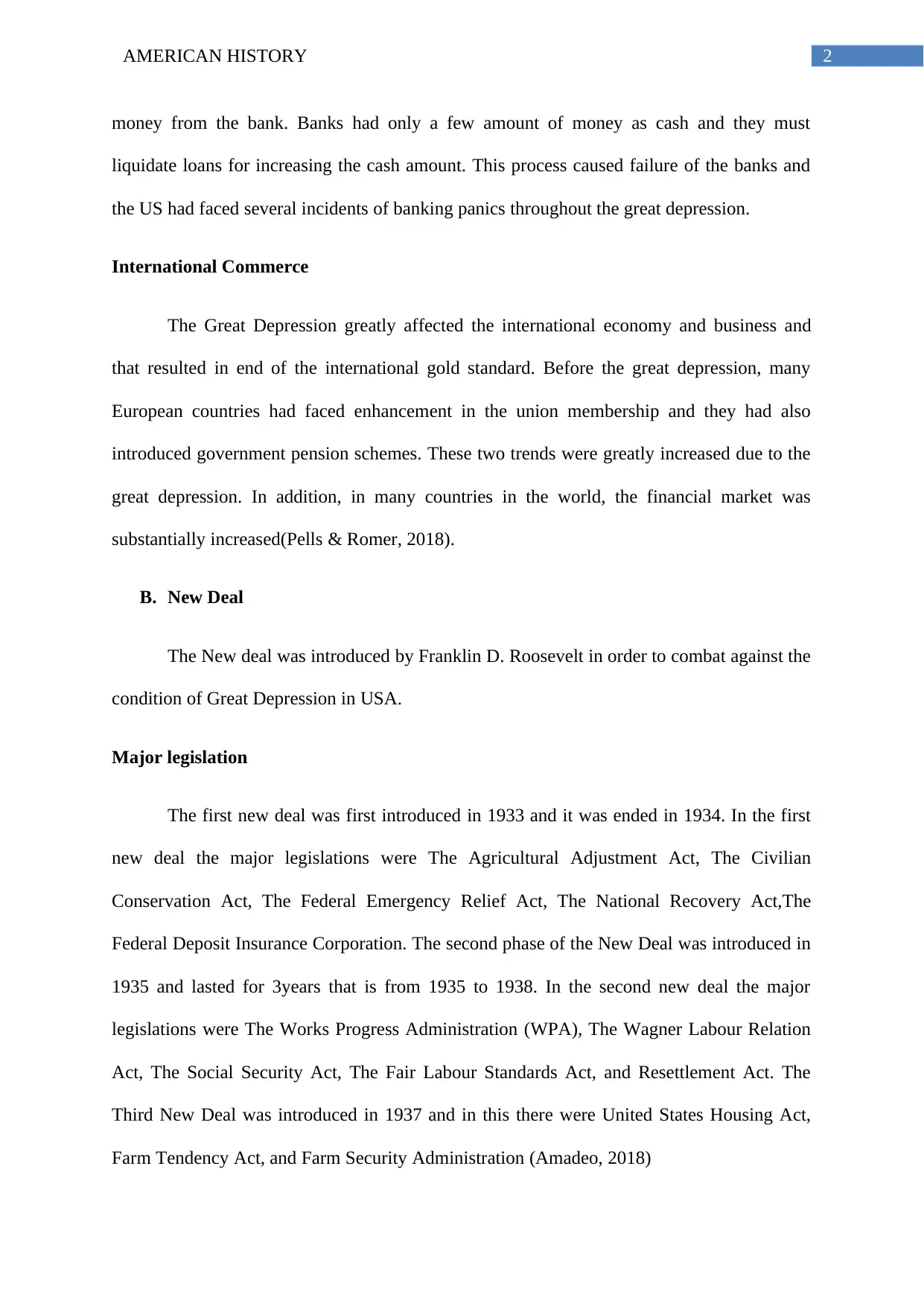
2AMERICAN HISTORY
money from the bank. Banks had only a few amount of money as cash and they must
liquidate loans for increasing the cash amount. This process caused failure of the banks and
the US had faced several incidents of banking panics throughout the great depression.
International Commerce
The Great Depression greatly affected the international economy and business and
that resulted in end of the international gold standard. Before the great depression, many
European countries had faced enhancement in the union membership and they had also
introduced government pension schemes. These two trends were greatly increased due to the
great depression. In addition, in many countries in the world, the financial market was
substantially increased(Pells & Romer, 2018).
B. New Deal
The New deal was introduced by Franklin D. Roosevelt in order to combat against the
condition of Great Depression in USA.
Major legislation
The first new deal was first introduced in 1933 and it was ended in 1934. In the first
new deal the major legislations were The Agricultural Adjustment Act, The Civilian
Conservation Act, The Federal Emergency Relief Act, The National Recovery Act,The
Federal Deposit Insurance Corporation. The second phase of the New Deal was introduced in
1935 and lasted for 3years that is from 1935 to 1938. In the second new deal the major
legislations were The Works Progress Administration (WPA), The Wagner Labour Relation
Act, The Social Security Act, The Fair Labour Standards Act, and Resettlement Act. The
Third New Deal was introduced in 1937 and in this there were United States Housing Act,
Farm Tendency Act, and Farm Security Administration (Amadeo, 2018)
money from the bank. Banks had only a few amount of money as cash and they must
liquidate loans for increasing the cash amount. This process caused failure of the banks and
the US had faced several incidents of banking panics throughout the great depression.
International Commerce
The Great Depression greatly affected the international economy and business and
that resulted in end of the international gold standard. Before the great depression, many
European countries had faced enhancement in the union membership and they had also
introduced government pension schemes. These two trends were greatly increased due to the
great depression. In addition, in many countries in the world, the financial market was
substantially increased(Pells & Romer, 2018).
B. New Deal
The New deal was introduced by Franklin D. Roosevelt in order to combat against the
condition of Great Depression in USA.
Major legislation
The first new deal was first introduced in 1933 and it was ended in 1934. In the first
new deal the major legislations were The Agricultural Adjustment Act, The Civilian
Conservation Act, The Federal Emergency Relief Act, The National Recovery Act,The
Federal Deposit Insurance Corporation. The second phase of the New Deal was introduced in
1935 and lasted for 3years that is from 1935 to 1938. In the second new deal the major
legislations were The Works Progress Administration (WPA), The Wagner Labour Relation
Act, The Social Security Act, The Fair Labour Standards Act, and Resettlement Act. The
Third New Deal was introduced in 1937 and in this there were United States Housing Act,
Farm Tendency Act, and Farm Security Administration (Amadeo, 2018)
⊘ This is a preview!⊘
Do you want full access?
Subscribe today to unlock all pages.

Trusted by 1+ million students worldwide
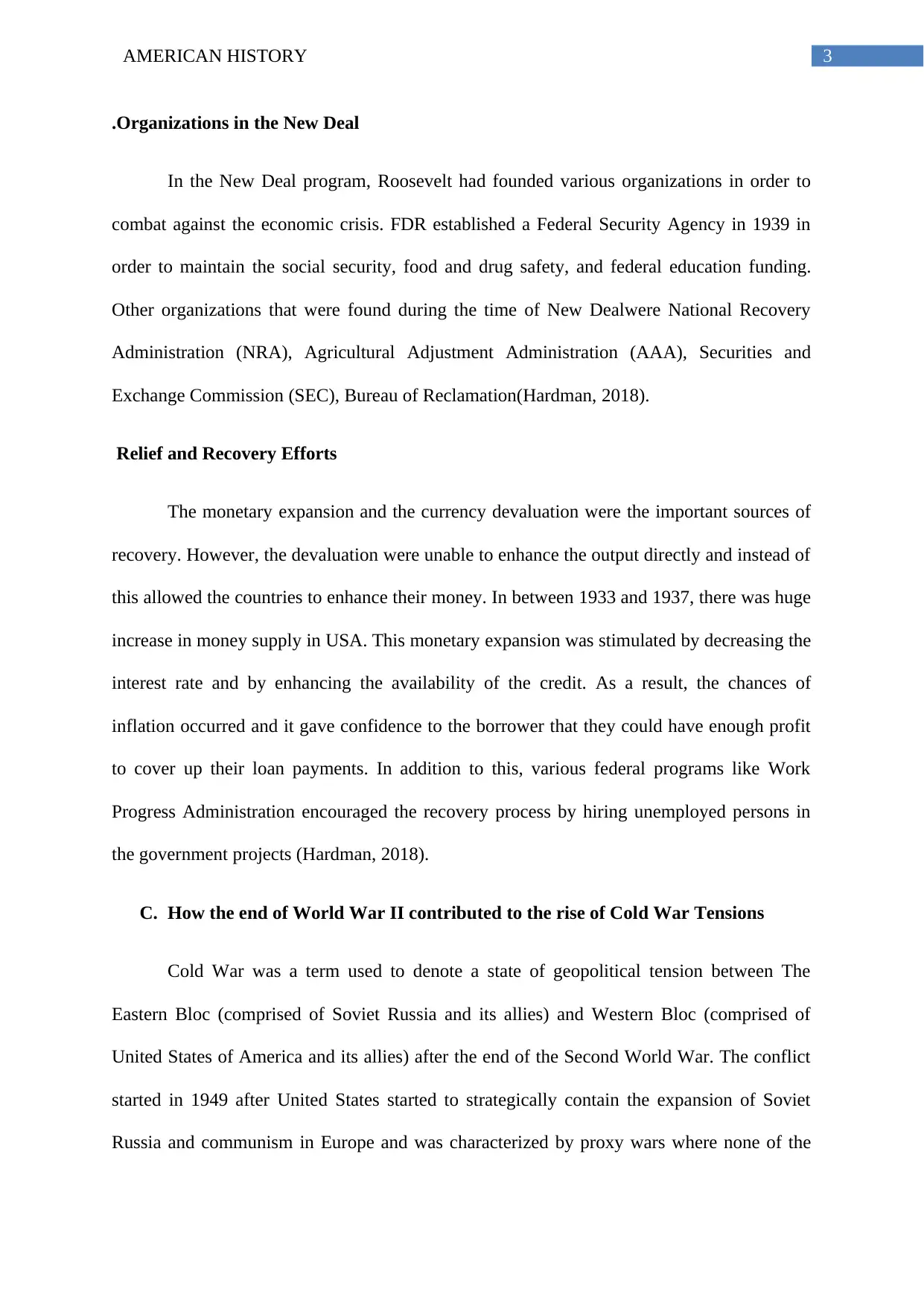
3AMERICAN HISTORY
.Organizations in the New Deal
In the New Deal program, Roosevelt had founded various organizations in order to
combat against the economic crisis. FDR established a Federal Security Agency in 1939 in
order to maintain the social security, food and drug safety, and federal education funding.
Other organizations that were found during the time of New Dealwere National Recovery
Administration (NRA), Agricultural Adjustment Administration (AAA), Securities and
Exchange Commission (SEC), Bureau of Reclamation(Hardman, 2018).
Relief and Recovery Efforts
The monetary expansion and the currency devaluation were the important sources of
recovery. However, the devaluation were unable to enhance the output directly and instead of
this allowed the countries to enhance their money. In between 1933 and 1937, there was huge
increase in money supply in USA. This monetary expansion was stimulated by decreasing the
interest rate and by enhancing the availability of the credit. As a result, the chances of
inflation occurred and it gave confidence to the borrower that they could have enough profit
to cover up their loan payments. In addition to this, various federal programs like Work
Progress Administration encouraged the recovery process by hiring unemployed persons in
the government projects (Hardman, 2018).
C. How the end of World War II contributed to the rise of Cold War Tensions
Cold War was a term used to denote a state of geopolitical tension between The
Eastern Bloc (comprised of Soviet Russia and its allies) and Western Bloc (comprised of
United States of America and its allies) after the end of the Second World War. The conflict
started in 1949 after United States started to strategically contain the expansion of Soviet
Russia and communism in Europe and was characterized by proxy wars where none of the
.Organizations in the New Deal
In the New Deal program, Roosevelt had founded various organizations in order to
combat against the economic crisis. FDR established a Federal Security Agency in 1939 in
order to maintain the social security, food and drug safety, and federal education funding.
Other organizations that were found during the time of New Dealwere National Recovery
Administration (NRA), Agricultural Adjustment Administration (AAA), Securities and
Exchange Commission (SEC), Bureau of Reclamation(Hardman, 2018).
Relief and Recovery Efforts
The monetary expansion and the currency devaluation were the important sources of
recovery. However, the devaluation were unable to enhance the output directly and instead of
this allowed the countries to enhance their money. In between 1933 and 1937, there was huge
increase in money supply in USA. This monetary expansion was stimulated by decreasing the
interest rate and by enhancing the availability of the credit. As a result, the chances of
inflation occurred and it gave confidence to the borrower that they could have enough profit
to cover up their loan payments. In addition to this, various federal programs like Work
Progress Administration encouraged the recovery process by hiring unemployed persons in
the government projects (Hardman, 2018).
C. How the end of World War II contributed to the rise of Cold War Tensions
Cold War was a term used to denote a state of geopolitical tension between The
Eastern Bloc (comprised of Soviet Russia and its allies) and Western Bloc (comprised of
United States of America and its allies) after the end of the Second World War. The conflict
started in 1949 after United States started to strategically contain the expansion of Soviet
Russia and communism in Europe and was characterized by proxy wars where none of the
Paraphrase This Document
Need a fresh take? Get an instant paraphrase of this document with our AI Paraphraser
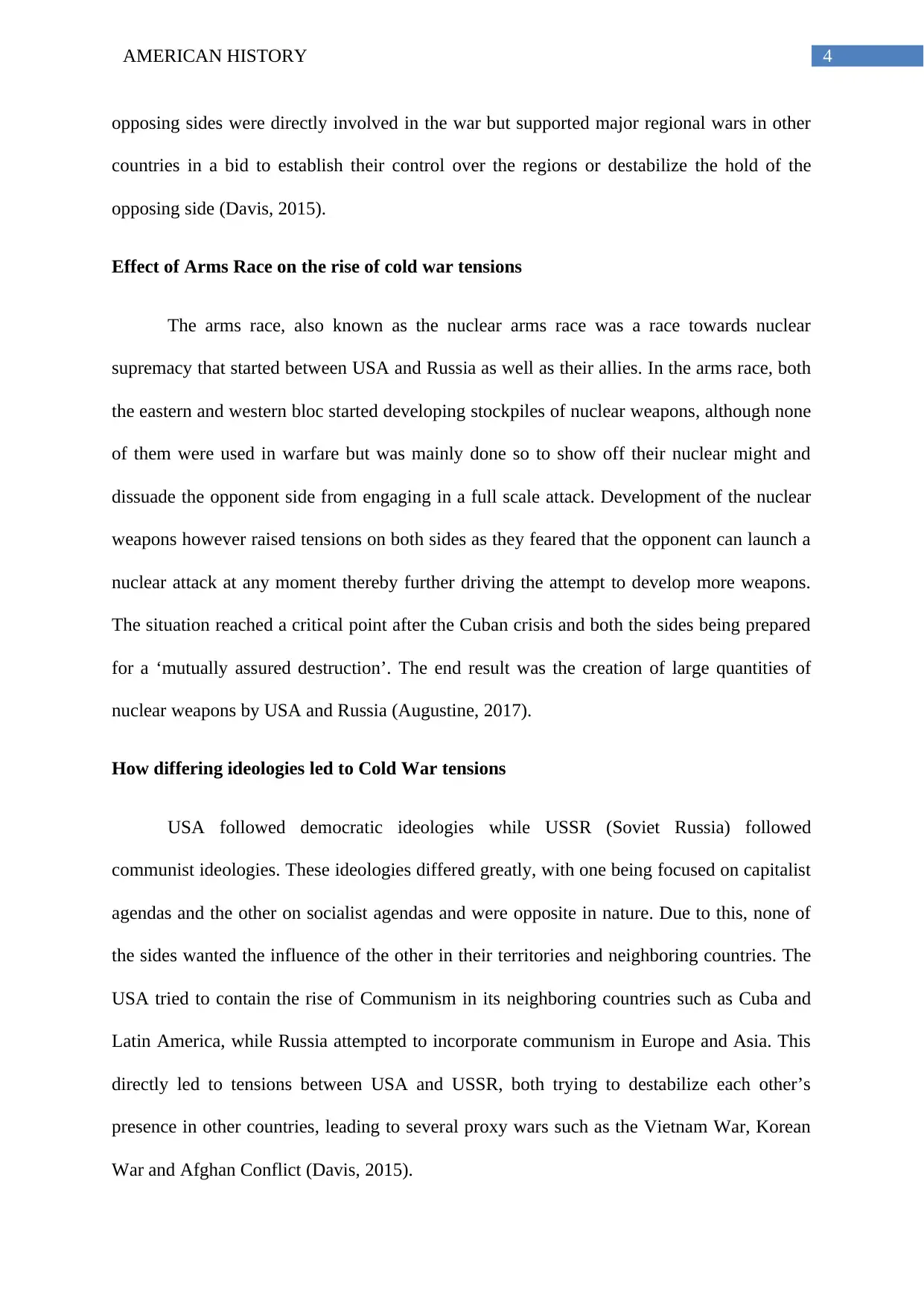
4AMERICAN HISTORY
opposing sides were directly involved in the war but supported major regional wars in other
countries in a bid to establish their control over the regions or destabilize the hold of the
opposing side (Davis, 2015).
Effect of Arms Race on the rise of cold war tensions
The arms race, also known as the nuclear arms race was a race towards nuclear
supremacy that started between USA and Russia as well as their allies. In the arms race, both
the eastern and western bloc started developing stockpiles of nuclear weapons, although none
of them were used in warfare but was mainly done so to show off their nuclear might and
dissuade the opponent side from engaging in a full scale attack. Development of the nuclear
weapons however raised tensions on both sides as they feared that the opponent can launch a
nuclear attack at any moment thereby further driving the attempt to develop more weapons.
The situation reached a critical point after the Cuban crisis and both the sides being prepared
for a ‘mutually assured destruction’. The end result was the creation of large quantities of
nuclear weapons by USA and Russia (Augustine, 2017).
How differing ideologies led to Cold War tensions
USA followed democratic ideologies while USSR (Soviet Russia) followed
communist ideologies. These ideologies differed greatly, with one being focused on capitalist
agendas and the other on socialist agendas and were opposite in nature. Due to this, none of
the sides wanted the influence of the other in their territories and neighboring countries. The
USA tried to contain the rise of Communism in its neighboring countries such as Cuba and
Latin America, while Russia attempted to incorporate communism in Europe and Asia. This
directly led to tensions between USA and USSR, both trying to destabilize each other’s
presence in other countries, leading to several proxy wars such as the Vietnam War, Korean
War and Afghan Conflict (Davis, 2015).
opposing sides were directly involved in the war but supported major regional wars in other
countries in a bid to establish their control over the regions or destabilize the hold of the
opposing side (Davis, 2015).
Effect of Arms Race on the rise of cold war tensions
The arms race, also known as the nuclear arms race was a race towards nuclear
supremacy that started between USA and Russia as well as their allies. In the arms race, both
the eastern and western bloc started developing stockpiles of nuclear weapons, although none
of them were used in warfare but was mainly done so to show off their nuclear might and
dissuade the opponent side from engaging in a full scale attack. Development of the nuclear
weapons however raised tensions on both sides as they feared that the opponent can launch a
nuclear attack at any moment thereby further driving the attempt to develop more weapons.
The situation reached a critical point after the Cuban crisis and both the sides being prepared
for a ‘mutually assured destruction’. The end result was the creation of large quantities of
nuclear weapons by USA and Russia (Augustine, 2017).
How differing ideologies led to Cold War tensions
USA followed democratic ideologies while USSR (Soviet Russia) followed
communist ideologies. These ideologies differed greatly, with one being focused on capitalist
agendas and the other on socialist agendas and were opposite in nature. Due to this, none of
the sides wanted the influence of the other in their territories and neighboring countries. The
USA tried to contain the rise of Communism in its neighboring countries such as Cuba and
Latin America, while Russia attempted to incorporate communism in Europe and Asia. This
directly led to tensions between USA and USSR, both trying to destabilize each other’s
presence in other countries, leading to several proxy wars such as the Vietnam War, Korean
War and Afghan Conflict (Davis, 2015).
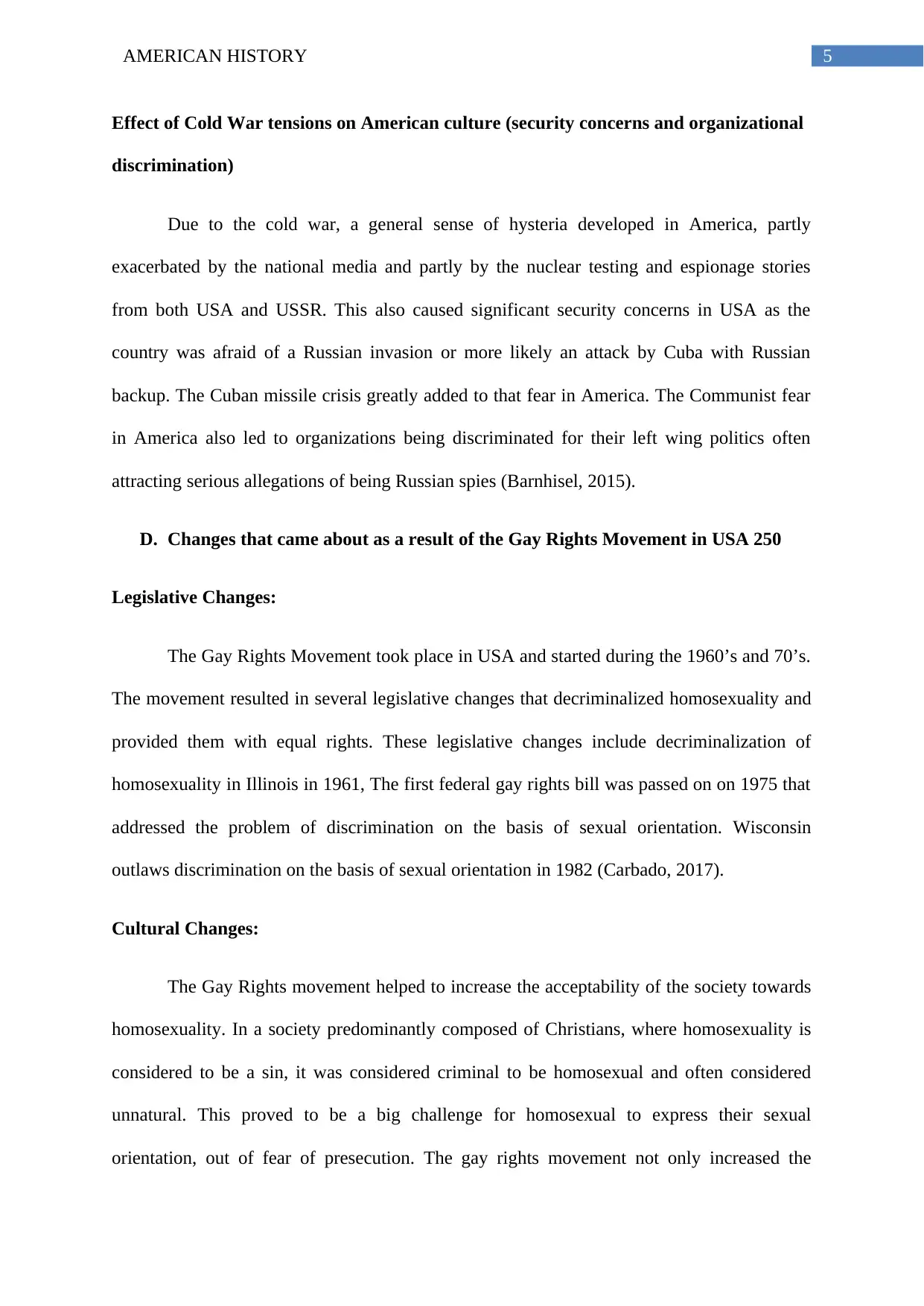
5AMERICAN HISTORY
Effect of Cold War tensions on American culture (security concerns and organizational
discrimination)
Due to the cold war, a general sense of hysteria developed in America, partly
exacerbated by the national media and partly by the nuclear testing and espionage stories
from both USA and USSR. This also caused significant security concerns in USA as the
country was afraid of a Russian invasion or more likely an attack by Cuba with Russian
backup. The Cuban missile crisis greatly added to that fear in America. The Communist fear
in America also led to organizations being discriminated for their left wing politics often
attracting serious allegations of being Russian spies (Barnhisel, 2015).
D. Changes that came about as a result of the Gay Rights Movement in USA 250
Legislative Changes:
The Gay Rights Movement took place in USA and started during the 1960’s and 70’s.
The movement resulted in several legislative changes that decriminalized homosexuality and
provided them with equal rights. These legislative changes include decriminalization of
homosexuality in Illinois in 1961, The first federal gay rights bill was passed on on 1975 that
addressed the problem of discrimination on the basis of sexual orientation. Wisconsin
outlaws discrimination on the basis of sexual orientation in 1982 (Carbado, 2017).
Cultural Changes:
The Gay Rights movement helped to increase the acceptability of the society towards
homosexuality. In a society predominantly composed of Christians, where homosexuality is
considered to be a sin, it was considered criminal to be homosexual and often considered
unnatural. This proved to be a big challenge for homosexual to express their sexual
orientation, out of fear of presecution. The gay rights movement not only increased the
Effect of Cold War tensions on American culture (security concerns and organizational
discrimination)
Due to the cold war, a general sense of hysteria developed in America, partly
exacerbated by the national media and partly by the nuclear testing and espionage stories
from both USA and USSR. This also caused significant security concerns in USA as the
country was afraid of a Russian invasion or more likely an attack by Cuba with Russian
backup. The Cuban missile crisis greatly added to that fear in America. The Communist fear
in America also led to organizations being discriminated for their left wing politics often
attracting serious allegations of being Russian spies (Barnhisel, 2015).
D. Changes that came about as a result of the Gay Rights Movement in USA 250
Legislative Changes:
The Gay Rights Movement took place in USA and started during the 1960’s and 70’s.
The movement resulted in several legislative changes that decriminalized homosexuality and
provided them with equal rights. These legislative changes include decriminalization of
homosexuality in Illinois in 1961, The first federal gay rights bill was passed on on 1975 that
addressed the problem of discrimination on the basis of sexual orientation. Wisconsin
outlaws discrimination on the basis of sexual orientation in 1982 (Carbado, 2017).
Cultural Changes:
The Gay Rights movement helped to increase the acceptability of the society towards
homosexuality. In a society predominantly composed of Christians, where homosexuality is
considered to be a sin, it was considered criminal to be homosexual and often considered
unnatural. This proved to be a big challenge for homosexual to express their sexual
orientation, out of fear of presecution. The gay rights movement not only increased the
⊘ This is a preview!⊘
Do you want full access?
Subscribe today to unlock all pages.

Trusted by 1+ million students worldwide
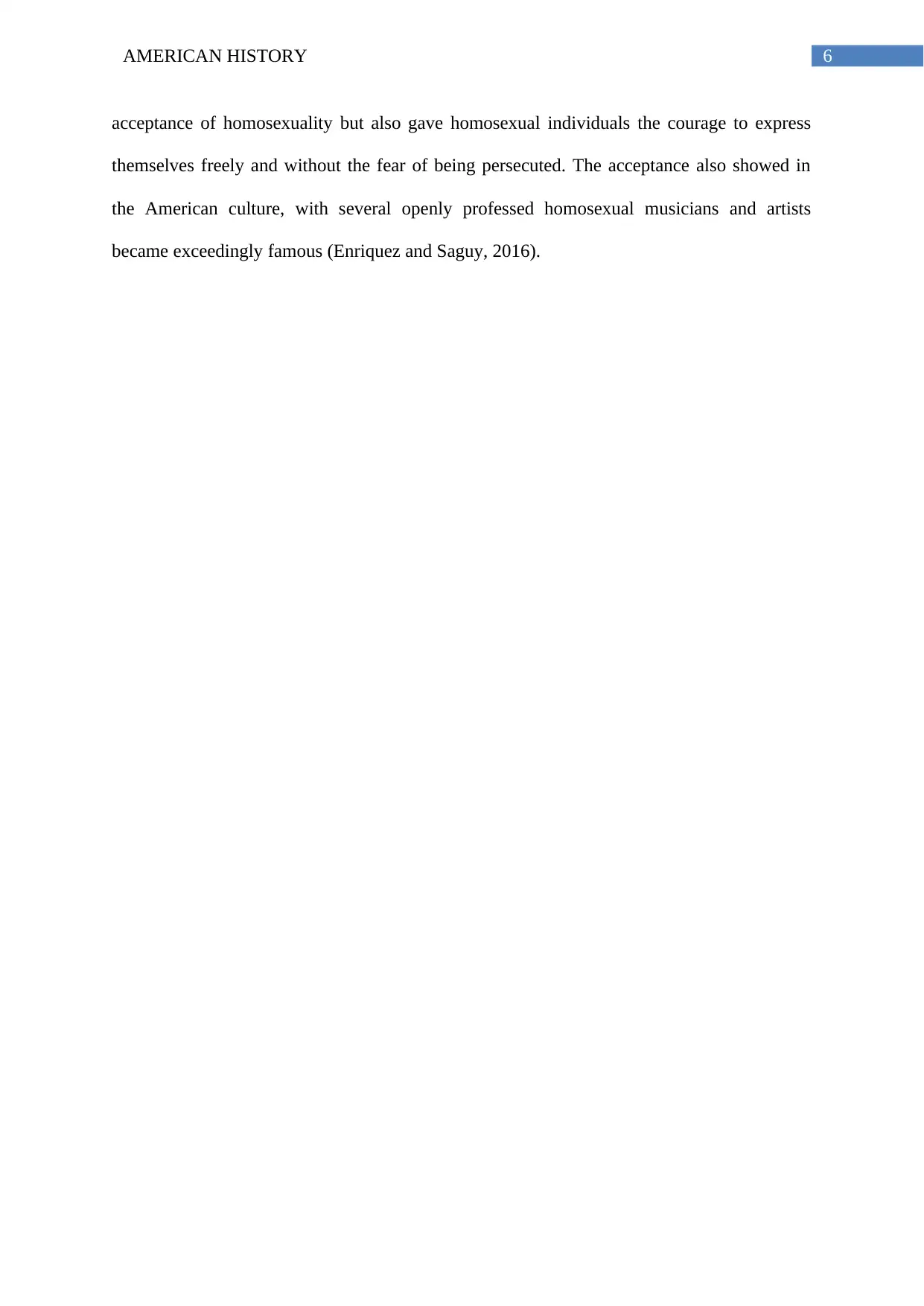
6AMERICAN HISTORY
acceptance of homosexuality but also gave homosexual individuals the courage to express
themselves freely and without the fear of being persecuted. The acceptance also showed in
the American culture, with several openly professed homosexual musicians and artists
became exceedingly famous (Enriquez and Saguy, 2016).
acceptance of homosexuality but also gave homosexual individuals the courage to express
themselves freely and without the fear of being persecuted. The acceptance also showed in
the American culture, with several openly professed homosexual musicians and artists
became exceedingly famous (Enriquez and Saguy, 2016).
Paraphrase This Document
Need a fresh take? Get an instant paraphrase of this document with our AI Paraphraser
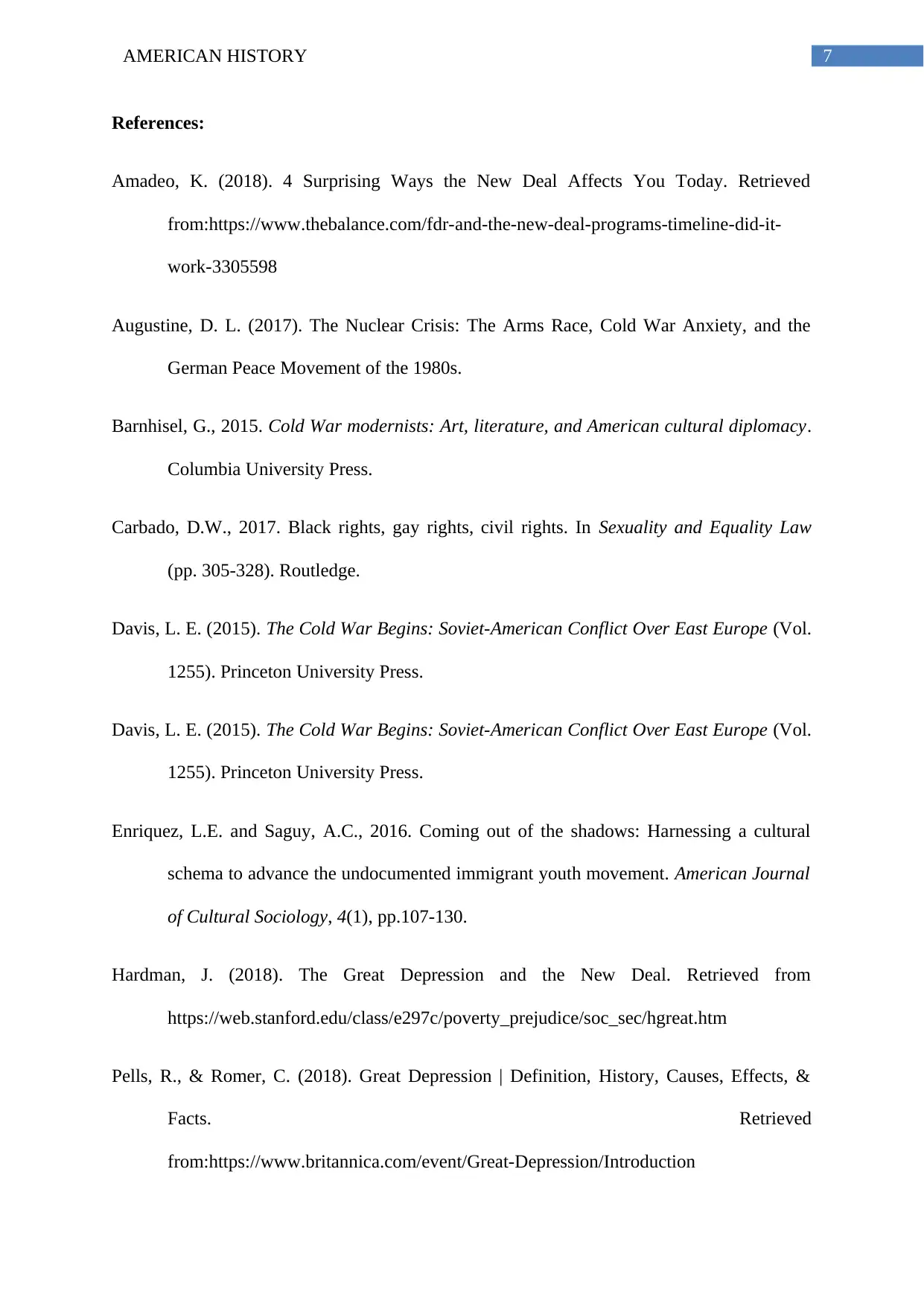
7AMERICAN HISTORY
References:
Amadeo, K. (2018). 4 Surprising Ways the New Deal Affects You Today. Retrieved
from:https://www.thebalance.com/fdr-and-the-new-deal-programs-timeline-did-it-
work-3305598
Augustine, D. L. (2017). The Nuclear Crisis: The Arms Race, Cold War Anxiety, and the
German Peace Movement of the 1980s.
Barnhisel, G., 2015. Cold War modernists: Art, literature, and American cultural diplomacy.
Columbia University Press.
Carbado, D.W., 2017. Black rights, gay rights, civil rights. In Sexuality and Equality Law
(pp. 305-328). Routledge.
Davis, L. E. (2015). The Cold War Begins: Soviet-American Conflict Over East Europe (Vol.
1255). Princeton University Press.
Davis, L. E. (2015). The Cold War Begins: Soviet-American Conflict Over East Europe (Vol.
1255). Princeton University Press.
Enriquez, L.E. and Saguy, A.C., 2016. Coming out of the shadows: Harnessing a cultural
schema to advance the undocumented immigrant youth movement. American Journal
of Cultural Sociology, 4(1), pp.107-130.
Hardman, J. (2018). The Great Depression and the New Deal. Retrieved from
https://web.stanford.edu/class/e297c/poverty_prejudice/soc_sec/hgreat.htm
Pells, R., & Romer, C. (2018). Great Depression | Definition, History, Causes, Effects, &
Facts. Retrieved
from:https://www.britannica.com/event/Great-Depression/Introduction
References:
Amadeo, K. (2018). 4 Surprising Ways the New Deal Affects You Today. Retrieved
from:https://www.thebalance.com/fdr-and-the-new-deal-programs-timeline-did-it-
work-3305598
Augustine, D. L. (2017). The Nuclear Crisis: The Arms Race, Cold War Anxiety, and the
German Peace Movement of the 1980s.
Barnhisel, G., 2015. Cold War modernists: Art, literature, and American cultural diplomacy.
Columbia University Press.
Carbado, D.W., 2017. Black rights, gay rights, civil rights. In Sexuality and Equality Law
(pp. 305-328). Routledge.
Davis, L. E. (2015). The Cold War Begins: Soviet-American Conflict Over East Europe (Vol.
1255). Princeton University Press.
Davis, L. E. (2015). The Cold War Begins: Soviet-American Conflict Over East Europe (Vol.
1255). Princeton University Press.
Enriquez, L.E. and Saguy, A.C., 2016. Coming out of the shadows: Harnessing a cultural
schema to advance the undocumented immigrant youth movement. American Journal
of Cultural Sociology, 4(1), pp.107-130.
Hardman, J. (2018). The Great Depression and the New Deal. Retrieved from
https://web.stanford.edu/class/e297c/poverty_prejudice/soc_sec/hgreat.htm
Pells, R., & Romer, C. (2018). Great Depression | Definition, History, Causes, Effects, &
Facts. Retrieved
from:https://www.britannica.com/event/Great-Depression/Introduction

8AMERICAN HISTORY
⊘ This is a preview!⊘
Do you want full access?
Subscribe today to unlock all pages.

Trusted by 1+ million students worldwide
1 out of 9
Related Documents
Your All-in-One AI-Powered Toolkit for Academic Success.
+13062052269
info@desklib.com
Available 24*7 on WhatsApp / Email
![[object Object]](/_next/static/media/star-bottom.7253800d.svg)
Unlock your academic potential
Copyright © 2020–2025 A2Z Services. All Rights Reserved. Developed and managed by ZUCOL.





